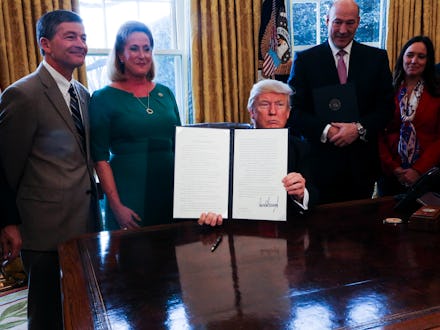How many executive orders can a president use? Here are the limits on Trump's influence.

In the days since President Donald Trump took office, he has signed a host of controversial executive orders — chief among them an immigration ban that ignited a legal firestorm and wreaked havoc in several U.S. airports and sparked protests around the world.
This spate of executive actions has left many wondering if there are limitations to the number of orders he can enact. Trump — or any president for that matter — has no restrictions nor a cap. To date, Franklin D. Roosevelt signed the largest number of executive orders for a total of 3,728 (though he was elected to four terms), followed by Woodrow Wilson with 1,803, Calvin Coolidge with 1,203 and Theodore Roosevelt with 1,081. Meanwhile, John Adams, James Madison and James Monroe signed only one executive order each.
To put things into perspective, former President Barack Obama signed 19 executive actions in his first 12 days, while Trump has signed 18 during the same period. Ironically, Trump was critical of Obama's use of executive orders, once calling it a "major power grab of authority."
By definition, an executive order is an official statement from the president suggesting changes to the nation's policies, according to the website FindLaw.com. Nevertheless, executive orders can be challenged.
What are the limits?
Executive orders are protected under Article II, Section 3 of the Constitution, which states that the President "shall take care that the laws be faithfully executed, and shall commission all the officers of the Untied States." These orders are used to influence issues in an array of areas, yet the great majority have dealt with war. For instance, President George W. Bush signed a series of executive orders following the 9/11 attacks, such as stopping the financing of terrorist organizations and the creation of the Department of Homeland Security.
But executive orders are also subject to checks and balances. According to FindLaw, the legal website, federal courts can challenge orders if they pose a threat to U.S. laws. Furthermore, the U.S. Supreme Court ruled out that executive orders "must fit within a certain sphere of power and cannot simply defy congressional intent."
Case in point: On Thursday night, a panel with the U.S. Court of Appeals for the 9th Circuit upheld U.S. District Judge James Robart's decision, which dictated that Trump's immigration ban should be put on hold. The main claim is that Trump's order "ran afoul of the Constitution in that it intentionally discriminated against Muslims," according to The Washington Post.
Another limitation on the power of executive orders: they can be rescinded by a subsequent president, or if Congress decides that they have the power to rule on a particular issue.
But executive orders do acquire a level of legitimacy if the president is acting with Congressional authority. They can still shape policy in case Congress remains silent on a particular issue, according to FindLaw.